

Rules will require carbon footprint disclosures and apply to manufacturers as well as importers and distributors.
Electric car batteries sold in the EU with a capacity above 2kWh will soon require a carbon footprint declaration and label, under rules designed to help inform consumers.
A provisional agreement reached between the European Parliament and Council in December 2022 will also set stricter targets for waste collection and introduce due diligence policy for the battery industry.
The agreement follows proposals laid in December 2020, known as the ‘battery regulation’. Certain obligations under the rules, such as the battery carbon footprint requirements, will be phased in gradually.
“For the first time, we have circular economy legislation that covers the entire life cycle of a product,” MEP Achille Variati said announcing the deal. “These measures could become a benchmark for the entire global battery market.”
The rules will apply to all kinds of batteries sold within the bloc, including those powering electric vehicles and scooters, as well as portable batteries.
Batteries will have labels and QR codes that explain their capacity and performance, while all EV batteries and those designed for light means of transport (LMT) – powering electric scooters and bikes – will need a digital battery passport if their capacities exceed 2kWh. This passport will include information on the battery model, as well as bespoke detail on its use.
Waste and due diligence obligations
With the exception of small and medium-sized businesses, any operator placing batteries in the EU market must develop due diligence policies in response to the environmental and social risks associated with “sourcing, processing and trading raw materials and secondary raw materials”, the European Parliament said.
The rules also cover the use and collection of materials. It is estimated that 53.6mn tonnes of electronic waste were generated globally in 2019, with the International Telecommunication Union expecting this to rise to 74.7mn tonnes by 2030. However, batteries from electric vehicles are typically excluded from official estimates of electronic waste, according to Barclays analysts.
“Lithium, nickel and cobalt in EV batteries are highly valuable and make up roughly half the cost of the battery, yet are not included in typical estimates of the value of electronic waste,” the analysts said in a November 2022 note. “Sourcing lithium and cobalt from electronic waste will be key, and has been highlighted as a priority in the EU’s Circular Economy Strategy.”
According to the EU’s battery regulation, all waste EV and LMT batteries, as well as so-called SLI batteries, which provide power for starting vehicles, will need to be collected free of charge for end-users.
The rules set the minimum levels of recovered cobalt and lead from manufacturing and consumer waste to be reused in new batteries at 16 per cent and 85 per cent, respectively. The minimum levels for both lithium and nickel have been set at 6 per cent.
The rules will extend beyond battery manufacturers, with battery traders – such as importers and distributors – needing to ensure documentation and labelling requirements are met, noted Osborne Clark senior associate Sylwia Uzieblo-Kowalska in a summary of the deal.
In certain cases, she added, “these entities may have obligations analogous to those applicable to battery manufacturers,” for example when importers or distributors make changes to a battery or alter its intended use.
Photo credit: Mikes-Photography/Pixabay
Similar Articles

Truckmakers must speed into action to meet zero emissions rules

Could wind energy help shipping cut its emissions sooner?


